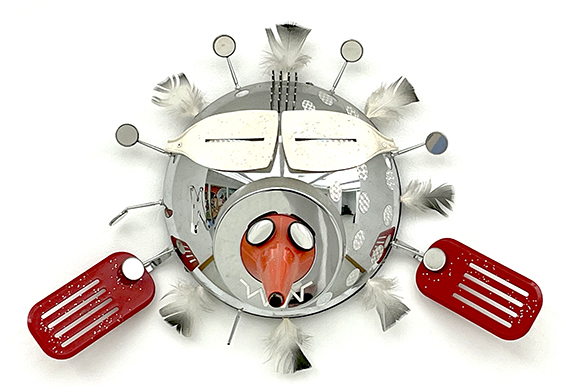
Lawrence J. Beck, Punk Mosquito Spirit
Lawrence J. Beck
1938-1994
Yup'ik
Alternative Name
Larry (James) Beck
Date
1984
Classification
Mixed Media
Dimensions
15 x 22 x 12 in. (38.1 x 55.9 x 30.5 cm)
Accession Number
1984.20.25.01
Credit
Gift of the Artist
Memo / Artist Statement
"Beck observes some conventions and traditions of Inuit art. He strives for visual simplicity and, life his ancestors, uses materials readily available in his environment. Seattle has many automobile parts stores and junk yards, and the Boeing factory in nearly Renton has a rich supply of surplus airplane parts for sale. Dental product stores and hardware stores are other gathering grounds." (Portfolio, American Indian Contemporary Arts, San Francisco, 1986: 7)
Biography
Beck was a Seattle born sculptor who was a one quarter Native Alaskan, and he was able to draw both inspiration and conflict from his mixed lineage. Throughout his life, Beck was able to create fine masterpieces out of assembled objects, forming public structure, industrial artworks and Inuit-inspired masked.
He attended the University of Washington where he earned a B.A. in painting and a M.F.A. in sculpture in 1965. While at UW, Larry was taught by George Tsutakawa and Everett Du Pen and visiting New York artist Gabriel Kohn. His art reflects the influences of sculptor David Smith, Mark di Suvero and Inuit artist Gariel Kohn.
During the late 1960s and 1970s, Larry focused on his large scale, abstract sculptures and established his reputation as a sculpture. Larry's early works were comprised of found metals and objects assembled in a lyrical but humorous manner. During 1975-1980, he installed projects for Golden Gardens Park in Seattle, Highline Community College and Boeing (King County Airport).
Although he was not raised around his ancestral homelands, Larry visited the Alaskan coast in the mid 1970s and learned the Yup'ik culture. In 1973 Larry started to produce a new series of pieces called "Inukshuk", which is Inuit for sculpture presence, a term used for three major commissions that later followed. Larry continued to use Inuit terminology in his work. This was the first sign that Larry started to embrace his multicultural heritage in his artwork. Larry experimented with making bronze and aluminum small castings of traditional Inuit masks, but he felt uneasy that these masks represented a complete contradiction to his western art training.
After the 1980 install of the Boeing sculpture, Beck experienced what he would call his sculpture career crisis. He became disappointed with public art. This is when Larry received his calling to start working on his abstract Inuit Inua (spirit) masks. Larry embraced the idea of using the ancestral ways of his Mother's people of finding natural objects and turning them into masks or art pieces. Larry utilized this method and found contemporary objects within junkyards and hardware stores to create his contemporary Inua masks. From this time on, Larry focused the remaining years of his life working on Inua masks.
(https://sova.si.edu/record/NMAI.AC.017?s=860&n=10&t=C&q=Negatives&i=867, 2020)
He attended the University of Washington where he earned a B.A. in painting and a M.F.A. in sculpture in 1965. While at UW, Larry was taught by George Tsutakawa and Everett Du Pen and visiting New York artist Gabriel Kohn. His art reflects the influences of sculptor David Smith, Mark di Suvero and Inuit artist Gariel Kohn.
During the late 1960s and 1970s, Larry focused on his large scale, abstract sculptures and established his reputation as a sculpture. Larry's early works were comprised of found metals and objects assembled in a lyrical but humorous manner. During 1975-1980, he installed projects for Golden Gardens Park in Seattle, Highline Community College and Boeing (King County Airport).
Although he was not raised around his ancestral homelands, Larry visited the Alaskan coast in the mid 1970s and learned the Yup'ik culture. In 1973 Larry started to produce a new series of pieces called "Inukshuk", which is Inuit for sculpture presence, a term used for three major commissions that later followed. Larry continued to use Inuit terminology in his work. This was the first sign that Larry started to embrace his multicultural heritage in his artwork. Larry experimented with making bronze and aluminum small castings of traditional Inuit masks, but he felt uneasy that these masks represented a complete contradiction to his western art training.
After the 1980 install of the Boeing sculpture, Beck experienced what he would call his sculpture career crisis. He became disappointed with public art. This is when Larry received his calling to start working on his abstract Inuit Inua (spirit) masks. Larry embraced the idea of using the ancestral ways of his Mother's people of finding natural objects and turning them into masks or art pieces. Larry utilized this method and found contemporary objects within junkyards and hardware stores to create his contemporary Inua masks. From this time on, Larry focused the remaining years of his life working on Inua masks.
(https://sova.si.edu/record/NMAI.AC.017?s=860&n=10&t=C&q=Negatives&i=867, 2020)
Date of Bio
